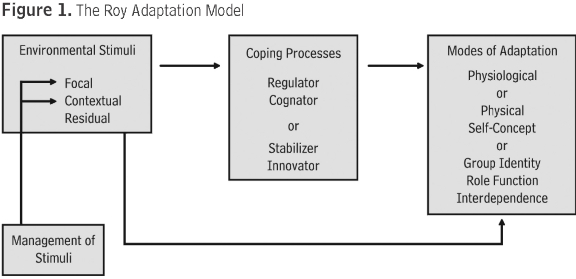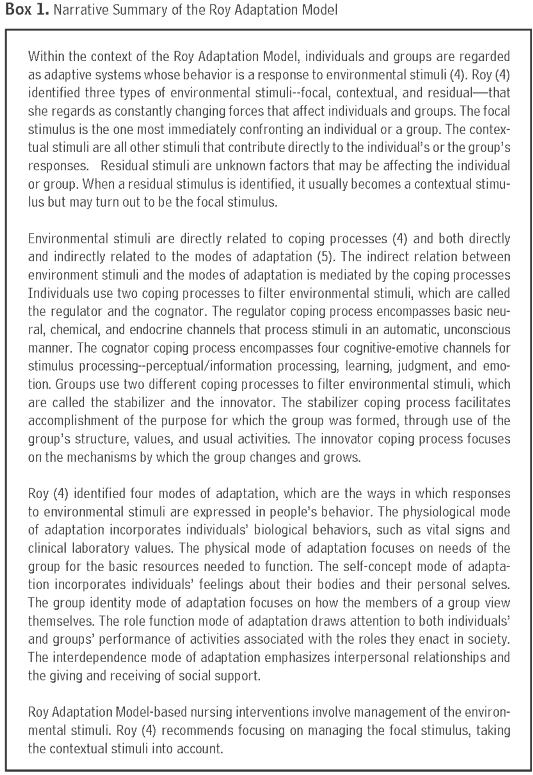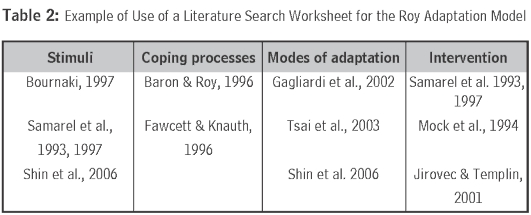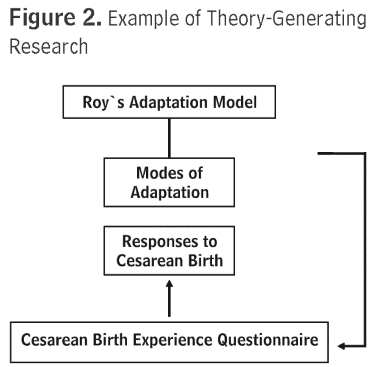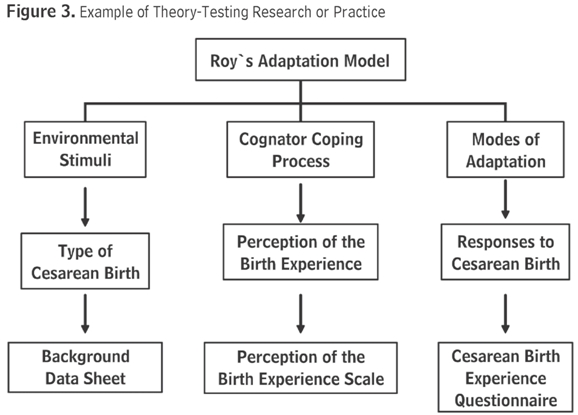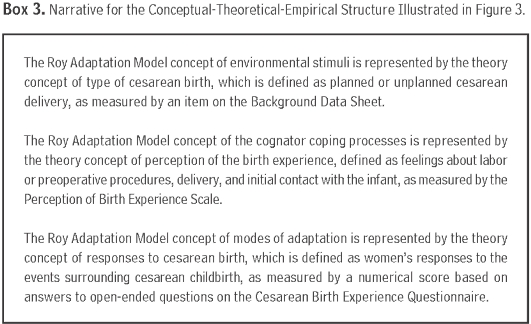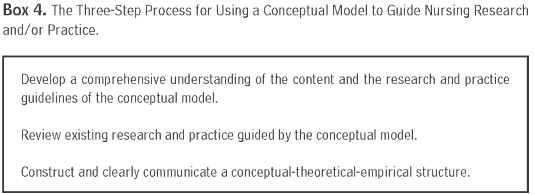Services on Demand
Journal
Article
Indicators
-
 Cited by SciELO
Cited by SciELO -
 Access statistics
Access statistics
Related links
-
 Cited by Google
Cited by Google -
 Similars in
SciELO
Similars in
SciELO -
 Similars in Google
Similars in Google
Share
Aquichan
Print version ISSN 1657-5997
Aquichan vol.9 no.3 Bogotá Sep./Dec. 2009
Using the Roy Adaptation Model to Guide Research and/or Practice: Construction of Conceptual-Theoretical-Empirical Systems of Knowledge
Uso del Modelo de Adaptación de Roy para guía de la investigación y/o la práctica: construcción de sistemas de conocimiento conceptuales-teóricos-empíricos
Aplicação do Modelo de Adaptação de Roy na pesquisa o na prática: construção de sistemas de conhecimento conceptual e teórico-empírico
Jacqueline Fawcett1
1 Professor, College of Nursing and Health Sciences. University of Massachusetts. Boston, USA. jacqueline.fawcett@umb.edu
Recibido: 26 de agosto de 2009
Aceptado: 2 de noviembre de 2009
ABSTRACT
This paper presents an explanation of a three-step process for the use of a conceptual model to guide nursing research and/or practice. Step 1 involves learning the content of the conceptual model and its research and practice guidelines. Step 2 requires a review of literature about the use of the model as a basis for research or practice. Step 3 focuses on construction and communication of a conceptual-theoretical-empirical structure for diverse research topics and practice situations. Emphasis is placed on application of the process to one conceptual model of nursing: the Roy Adaptation Model.
KEY WORDS
Roy Adaptation Model, research, practice, nursing. (Source: DeCs, BIREME).
RESUMEN
Este artículo presenta una explicación para un proceso de tres pasos sobre el uso de un modelo conceptual para guía de la investigación y/o la práctica de la enfermería. El paso 1 implica el conocimiento del modelo conceptual y sus directrices para la investigación y la práctica. El paso 2 exige una revisión de la literatura sobre el uso del modelo como base para la investigación o la práctica. El paso 3 se enfoca en la construcción y la comunicación de una estructura conceptual - teórica - empírica sobre los diversos temas de investigación y las situaciones de práctica. El énfasis se hace sobre la aplicación del proceso a un modelo conceptual de enfermería: el Modelo de Adaptación de Roy.
PALABRAS CLAVE
Modelo de Adaptación de Roy, investigación, práctica, enfermería. (Fuente: DeCs, BIREME).
RESUMO
Este artigo oferece uma explicação para um processo de três passos sobre o uso de um modelo conceitual para orientar a pesquisa ou a prática de enfermagem. O passo 1 implica um conhecimento do modelo conceptual e suas diretrizes para a pesquisa e a prática. O passo 2 requer uma revisão da literatura sobre a utilização do modelo como base para a investigação ou a prática. O passo 3 centra-se na construção e a comunicação de um quadro conceptual e teórico-empírico sobre temas de investigação e várias situações de prática. A ênfase está na aplicação do processo em um modelo conceitual de enfermagem: o Modelo de Adaptação de Roy.
PALAVRAS-CHAVE
Modelo de Adaptação de Roy, investigação, práctica, enfermagem. (Fonte: DeCs, BIREME).
Introduction
The purpose of this paper is to present an explanation of three steps that need to be followed to use a conceptual model to guide nursing research and/or practice. The content of the paper reflects my belief that it is impossible to conduct nursing research or to practice nursing without guidance from a conceptual model. Indeed, Popper (1) pointed out that it is "absurd" (p. 46) to assume that development of any theory can occur without guidance from a conceptual model. The paper content also reflects my beliefs that the product of research always is a theory, and that nursing practice should be guided by nursing theories that are derived from nursing conceptual models.
Steps to Follow to Use a Conceptual Model to Guide Nursing Research and/or Practice
The use of a conceptual model to guide research and/or practice involves a process made up of three steps (2). The three steps are listed here.
1. Develop a comprehensive understanding of the content and the research and practice guidelines of the conceptual model.
2. Review existing research and practice guided by the conceptual model.
3. Construct and clearly communicate a conceptual-theoretical-empirical structure.
Step 1: Conceptual Model Content and Guidelines for Research and Practice The first step of the process of using a conceptual model to guide nursing research and/or practice is to understand the content of the conceptual model and to read carefully the guidelines for research and the guidelines for practice (2). A conceptual model is made up of abstract and general concepts and statements about those concepts (3). The content of the Roy Adaptation Model, for example, is made up of such abstract concepts as environmental stimuli, coping processes, and modes of adaptation; the statements that broadly define each concept; and the statements that link the concepts (see Figure 1). A narrative summary of the Roy Adaptation Model is given in Box 1.
Fawcett (3) identified guidelines for nursing research and guidelines for nursing practice based on the Roy Adaptation Model. The guidelines for research are listed here (3, pp. 385-396).
• The purpose of Roy Adaptation Model-guided research is to study the concepts and propositions of the model, which requires both basic nursing research and clinical nursing research.
The purpose of basic nursing research is to understand and explain people adapting within their life situations. The purpose of clinical research is to develop and test interventions and other strategies designed to enhance positive life processes and patterns.
• The phenomena of interest to Roy Adaptation Model-guided research encompass the content that is depicted in Figure 1. The problems to be studied include those stemming from the attempts made by individuals to meet their needs for physiological, psychological, spiritual, social, and relational integrity, as well as problems stemming from attempts made by groups to meet their collective needs for resource adequacy, identity and relational integrity, and role clarity.
• Participants in Roy Adaptation Model-guided research may be individuals or groups who are well or who have acute or chronic medical conditions. Appropriate research methods include qualitative and quantitative descriptive, correlational, and experimental research design. Data may be gathered in any health care setting in which human adaptive systems are found. Research instruments should reflect the unique focus and intent of the Roy Adaptation Model.
• Data analysis techniques encompass qualitative content analysis and nonparametric and parametric statistical procedures, with an emphasis on statistical techniques that facilitate analysis of nonlinear and reciprocal relations.
The guidelines for practice are listed here (3, p. 388).
• The broad purpose of Roy Adaptation Model-based nursing practice is to promote the ability of human adaptive systems to adjust effectively to changes in the environment and also to create changes in the environment.
• Practice problems of interest encompass adaptive and ineffective behavioral responses of human adaptive systems in the physiological/physical, self-concept/ group identity, role function, and interdependence adaptive modes.
• Nursing may be practiced in any setting in which nurses encounter individuals and groups, ranging from virtually every type of health care institution to people's homes and the community at large.
• Legitimate participants in nursing practice are human adaptive systems, including individuals, families and other groups, communities, and society, that are considered sick or well. Those adaptive systems may or may not manifest specific adaptation problems and ineffective behavioral responses.
• The nursing practice process is the Roy Adaptation Model nursing process. The components of the process are assessment of behavior, assessment of stimuli, nursing diagnosis, goal setting, intervention, and evaluation.
Step 2: Review of Literature The second step in the process of using a conceptual model to guide research and/or practice is to search and critically review the literature about the research topic or practice situation (2). The concepts of the conceptual model can be used as the basis for search terms and to categorize the results of the literature search.
The Cumulative Index to Nursing and Allied Health Literature (CINAHL) is an excellent electronic database for searches of literature about nursing conceptual models. For example, a CINAHL search term is Roy Adaptation Model. That search term can be combined with the search term, research, as well as with one or more search terms that reflect the specific research topic or practice situation. Suppose, for example, you are interested in studying women's responses to cesarean birth. Combining the search terms, Roy Adaptation Model, research, and cesarean, will yield relevant literature. Or, suppose you are interested in the postpartum care of women who have had a cesarean delivery. Literature that is relevant for this practice situation can be obtained by combining the search terms, Roy Adaptation Model, practice, postpartum, and cesarean.
The citations to literature that are obtained from the search of the database can be retrieved, reviewed for relevance, and then categorized using the concepts of the conceptual model. A worksheet that can be used to organize literature about the Roy Adaptation Model is shown in Table 1. An example of use of the worksheet is given in Table 2.
Step 3: Construct and Communicate the Conceptual-Theoretical-Empirical Structure
The third step in the process of using a conceptual model to guide research and/or practice requires the construction of a conceptual-theoretical-empirical (CTE) structure and communication of that structure in a diagram and a narrative (2). The components of a CTE are the conceptual model (C) that is the basis for the research topic or practice situation, the theory (T) that is to be generated or tested, and the empirical indicators (E) that provide a way to directly observe the theory.
Recall that the definition of a conceptual modelthe C componentis a set of abstract and general concepts and statements about those concepts. The concepts and statements that make up a conceptual model are too broad to be used directly in research or practice. Instead, theories the T component - are derived from the conceptual model and then are translated into empirical indicatorsthe E component.
A theory is made up of relatively specific and concrete concepts and statements about the concepts (3). For example, a theory of adaptation to cesarean birth, which was derived from the Roy Adaptation Model, is made up of three conceptstype of cesarean birth (planned or unplanned), perception of the birth experience, and responses to cesarean birth, as well as the definition of each concept and three statements linking the concepts. The type of cesarean birth is directly related to responses to childbirth, perception of the birth experience is related to responses to cesarean birth, and the indirect relation between the type of cesarean birth and responses to cesarean birth is mediated by perception of the birth experience (6).
An empirical indicator is a very concrete and specific substitute for a theory concept that allows the concept to be measured for research purposes or observed in practice situations (3). For example, perception of the birth experience can be measured by the Perception of Birth Experience Scale (POBES), and responses to cesarean birth can be measured by the Cesarean Birth Experience Questionnaire (CBEQ). Many empirical indicators, including the POBES and the CBEQ, can be used as research instruments and as practice tools (7).
Inductive Reasoning: Theory-Generating Research
The CTE structure for theory-generating research is constructed inductively, proceeding from the conceptual model to the empirical indicators to the theory. An example of a CTE structure for a Roy Adaptation Model-guided theory-generating study is shown in Figure 2.
Deductive Reasoning: Theory-Testing Research and Practice
In contrast, the CTE structure for theory-testing research and/or for practice is constructed deductively, proceeding from the conceptual model to the theory to the empirical indicators. An example of a CTE structure for a Roy Adaptation Model-guided theory-testing study or practice situation is shown in Figure 3. Inasmuch as theory-testing research and practice are essentially the same process, the CTE structure is the same. This means that the research process and the nursing practice process are equivalent processes (7). For example, the statement of the problem in research is the same as the assessment phase of the nursing practice process, and conduct of the research is the same as the intervention phase of the nursing practice process.
Narrative Description of the CTE Structure
Figures 2 and 3 are diagrams of CTE structures. The narrative that accompanies the diagrams should clearly communicate what is illustrated in the diagram. Clear communication can be accomplished by following the directions given here.
For theory-generating research and for theory-testing research and/or practice, follow these directions:
• State the name of the conceptual model.
• Provide a narrative summary of the content of the conceptual model.
An example of the application of these directions is seen in Box 1, which contains the name of a conceptual model - the Roy Adaptation Model in this example - and a narrative summary of the content of that conceptual model.
For theory-generating research, also follow these directions:
• State the linkage from the conceptual model to the empirical indicator-Conceptual model concepta guided the construction of Interview Schedulez.
• State the linkages between the empirical indicators and the theory concept(s)--Analysis of the data obtained from study participants who responded to Interview Schedulez revealed the Theory of X, which is made up of the concept of A and its definition.
An example of the application of these directions is seen in Box 2, which provides the narrative for the CTE structure illustrated in Figure 2.
For theory-testing research and/or practice, also follow these directions:
• State the linkages between the conceptual model concepts and the theory concepts--Conceptual model concept A is represented by theory concepta. Conceptual model concept B is represented by theory conceptb. .. .Conceptual model conceptN is represented by theory conceptn.
• Define each theory concept: -Concepta is defined as .. , Conceptb is defined as .. , Conceptn is defined as ..
• State the linkages between the theory concepts and the empirical indicatorsTheory concepta will be measured by Empirical Indicatora, Theory conceptb will be measured by Empirical Indicatorb, Theory conceptn will be measured by Empirical Indicatorn.
• An example of the application of these directions is seen in Box 3, which provides the narrative for the CTE structure illustrated in Figure 3.
Conclusion
When conceptual model guided theory-testing research and/or practice are regarded as equivalent processes, the contributions made by both researchers and practicing nurses to theory development become obvious. However, the contributions will remain unrecognized if the work is not clearly communicated to others.
The use of a conceptual model to guide nursing research and/or practice sometimes seems very complicated. However, following the three-step process (Box 4) that is explained in this paper can simplify thinking about and communicating how you are using a conceptual model to guide your research and/or practice.
REFERENCES
1. Popper KR. Conjectures and Refutations. City (State): publisher, 1965. [ Links ]
2. Fawcett J, E Gigliotti. Using Conceptual Models of Nursing to Guide Nursing Research: The Case of the Neuman Systems Model. Nurs Sci Quarterly 2001; 14(4): 339-45. [ Links ]
3. Fawcett J. Contemporary Nursing Knowledge: Analysis and Evaluation of Nursing Models and Theories. 2 ed. Philadelphia (PA): FA Davis Company; 2005. [ Links ]
4. Roy C. The Roy Adaptation Model. 3 ed. Upper Saddle River (NJ): Pearson Education; 2009. [ Links ]
5. Fawcett J. The Roy Adaptation Model. Japanese J Nurs Res 2003; 36(2): 67-73. [ Links ]
6. Fawcett J, S.T. Myers, J.L. Hall, and L. Waters. Women's Adaptation to Cesarean Birth: Oklahoma Site. In: Fawcett J, Garity, J. Evaluating Research for Evidence-based Nursing Practice. Philadelphia (PA): FA Davis Company, 2009; on book CD. [ Links ]
7. Fawcett J, Garity J. Evaluating Research for Evidence-based Nursing Practice. Philadelphia (PA): FA Davis Company; 2009. [ Links ]













